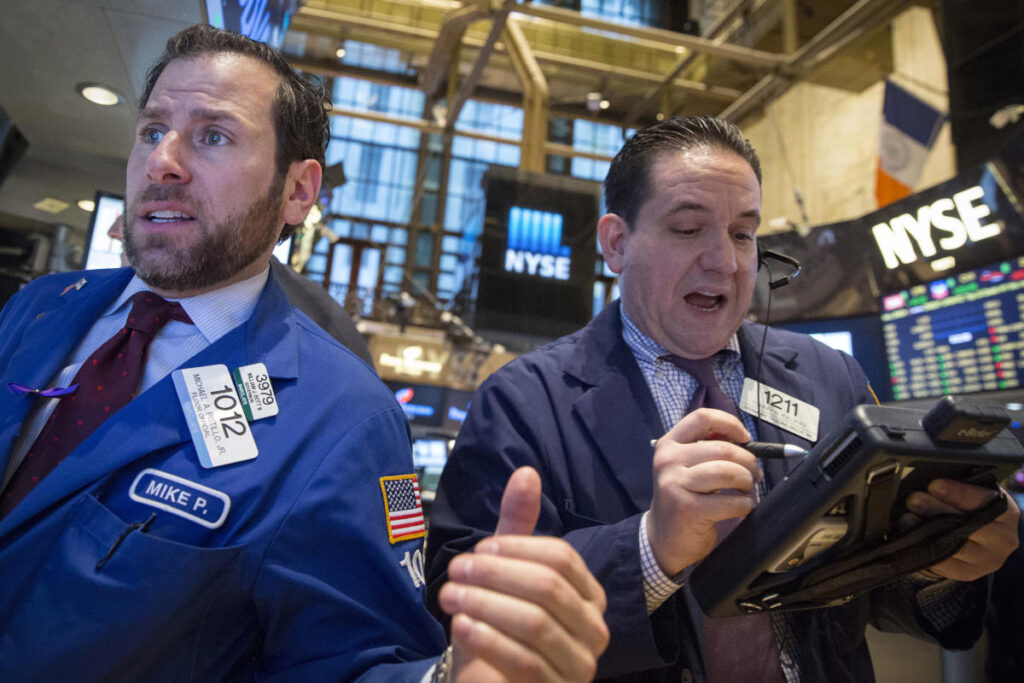Stocks fell on Thursday after a sharply lower-than-expected reading on US GDP for the first quarter ratcheted up questions about the health of the US economy in the face of persistently high interest rates. Meanwhile, Meta’s (META) revenue forecast rattled tech investors eyeing the next high-stakes megacap earnings.
The Nasdaq Composite (^IXIC) fell about 0.6%. The S&P 500 (^GSPC) lost less than 0.5%, while the Dow Jones Industrial Average (^DJI) slipped about 1%, or nearly 400 points. The indexes did recover from deeper losses earlier in the session.
US GDP growth came in at a 1.6% annualized pace in the first quarter, falling well short of expectations of 2.5%. The reading comes amid ongoing debate about the path of the Federal Reserve’s interest rate campaign. Meanwhile, an underlying measure of inflation grew by 3.7% in the first quarter, above estimates and significantly higher than a 2% gain in the prior quarter.
Treasury yields rose after the print, with the benchmark 10-year yield (^TNX) surging to its highest levels of the year before hovering around 4.7%.
Meanwhile, Meta shares sank more than 10% as the market balked at rising costs at the Facebook and Instagram owner, which plans to spend up to $10 billion on AI infrastructure investments. Concerns grew about how long it will take for that spending to feed into revenue, pulling down tech stocks more broadly. Microsoft (MSFT), Alphabet (GOOGL, GOOG), and Amazon (AMZN) were all down for the day.
Caterpillar (CAT) shares also sank about 6% after the heavy equipment maker said it continues to see weakness in Europe and economic softening in the Asia-Pacific, excluding China.
On the macroeconomic front, the spotlight will turn to the March reading of the Personal Consumption Expenditures index, the Fed’s favored inflation gauge, set for release on Friday.
Live16 updates
-
Alphabet surges after earnings beat, announcing cash dividend
Alphabet shares (GOOG, GOOGL) soared more than 11% after the company topped Wall Street’s earnings estimates and announced a cash dividend program of $0.20 per share.
The board of directors also approved a stock repurchases up to an additional $70 billion.
Here are some of Alphabet’s most significant metrics compared to what Wall Street was expecting in the company’s fiscal fourth quarter, according to data from Bloomberg:
-
Revenue, excluding traffic acquisition costs: $67.59 billion vs. $66.07 billion expected ($58.07 billion in Q1 2023)
-
Adjusted earnings per share: $1.89 vs. $1.53 expected ($1.17 in Q1 2023)
-
Cloud revenue: $9.58 billion vs. $9.37 billion expected ($7.45 billion in Q1 2023)
-
Ad revenue: $61.66 billion vs. $60.18 billion expected ($54.55 billion in Q1 2023)
-
-
What to watch in Thursday earnings after the bell
Another onslaught of corporate reports is set to hit the tape after the closing bell.
Below are some of the key companies and metrics we’ll be watching.
Microsoft
For the quarter, Wall Street is calling for Microsoft to report earnings per share of $2.83 on revenue of $60.88 billion, according to analysts’ estimates compiled by Bloomberg. In the same period last year, Microsoft reported EPS of $2.45 on revenue of $52.86 billion.
Analysts are looking for Microsoft to announce overall commercial cloud revenue of $33.93 billion in the quarter, a 19% year-over-year increase. In terms of business segments, Wall Street anticipates Microsoft will report Productivity and Business Processes revenue of $19.54 billion, Intelligent cloud revenue of $26.25 billion, and More Personal Computing revenue of $15.07 billion.
Read more from Yahoo Finance’s Dan Howley.
Alphabet
Here’s what Wall Street is expecting for some of Alphabet’s most significant metrics in the company’s fiscal first quarter, according to Bloomberg data:
-
Revenue, excluding traffic acquisition costs: $66.07 billion expected ($58.07 billion in Q1 2023)
-
Adjusted earnings per share: $1.53 expected ($1.17 in Q1 2023)
-
Cloud revenue: $9.37 billion expected ($7.45 billion in Q1 2023)
-
Ad revenue: $60.18 billion expected ($54.55 billion in Q1 2023)
Read more from Yahoo Finance’s Hamza Shaban
Intel
For the quarter, Wall Street is expecting Intel to report earnings of $0.13 per share on revenue of $12.7 billion, according to consensus data compiled by Bloomberg. The company reported a loss per share of $0.04 on revenue of $11.7 billion in the same quarter last year.
Read more from Yahoo Finance’s Dan Howley.
-
-
Mortgage rates hit highest level since November 2023
Mortgage rates ticker higher again this week to 7.17%, the highest since November.
Yahoo Finance’s Gabriella Cruz-Martinez reports:
Mortgage rates continued their climb past the 7% threshold this week, sidelining price-sensitive buyers in their wake.
The rate on the 30-year fixed rate mortgage rose to 7.17% on Thursday, up from 7.1% the week prior, according to Freddie Mac. Rates surged past 7% last week for the first time this year following a government report showing inflation remained hotter than expected.
A separate measure, which tracks rate changes daily, revealed even bigger swings. The daily rate on the popular 30-year fixed loan was 7.52% on Thursday, the highest reading since November 2023, according to Mortgage News Daily.
The uptick in rates was a sour note for would-be buyers hoping to get into the spring market, forcing some first-time and repeat buyers back on the sidelines.
Any hope of seeing rates stabilize will be contingent on inflation, said Jiayu Xu, an economist at Realtor.com.
“Unfortunately, the rising mortgage rates occurred during what is typically a busy time in the housing market, potentially giving pause to prospective homebuyers as they weigh their purchasing decisions,” Xu said. “Despite the increased mortgage rates leading to higher costs, it could also suggest a less competitive market where opportunities may exist for some homebuyers.”
-
Another worrisome sign on the inflation front
New data revealed a slowdown in the US economy in the first three months of the year. But even more concerning to investors was that inflation accelerated faster than Wall Street had expected, sending shockwaves through markets on Thursday.
The latest data from the Bureau of Economic Analysis showed the “core” Personal Consumption Expenditures (PCE) index, which excludes the volatile food and energy categories, grew by 3.7% year-over-year in the first quarter, above estimates for 3.4%, and significantly higher than 2% gain seen in the prior quarter.
This marked the first quarterly increase in the Fed’s preferred inflation gauge in a year, underscoring concerns that the central bank may not cut interest rates as quickly as it has projected.
“The difficult part [of Thursday’s data release] for the Fed and for the markets was core PCE was the inflation print,” Deutsche Bank senior US economist Brett Ryan told Yahoo Finance. “And that’s really what is troublesome from the Fed’s perspective, and why the market reacted, you know, quite negatively because it really, it really puts the Fed in awkward position and you start to question whether they can cut at all this year.”
He added that the data could have implications for a separate inflation print scheduled for release Friday. Consensus had expected a 0.3% month-over-month increase in core price in March.
But Ryan notes that Thursday’s reading on price increases for the quarter indicates that either March’s PCE reading will be hotter than expected, or revisions will show inflation was actually higher than previously thought in January and February. Neither bodes well for rate cut prospects, which now have the market pricing in just one rate cut this year.
-
Peacock losses narrow as subscribers jump
Comcast (CMCSA) shares fell about 7% on Thursday following a mixed first quarter earnings report that saw domestic broadband subscribers fall year over year.
But the company reported subscriber additions for its flagship streaming service Peacock, which added 3 million subs while revenue at the platform increased 54% year on year to $1.1 billion.
Losses at Peacock narrowed to $639 million compared to a loss of $704 million in the prior-year period. The company previously said 2023 would be the year of “peak losses” at the streaming service.
“We are really pleased with Peacock’s trajectory,” Comcast CFO Jason Armstrong said during the company’s first quarter earnings call. “We started the year with an incredibly successful NFL wild card game, which resulted in a nice lift to paid subs. But even more important was how our broad content offering enabled strong consumer acquisition, retention and engagement.”
In total, Peacock subscribers have climbed 55% year over year to reach 34 million. The company said consumers are spending 90% of their time on the platform viewing non-sports content, which includes original scripted series like “Ted” and “Apples Never Fall” along with reality programs like “The Traitors.”
“Oppenheimer”, which premiered exclusively on Peacock in February, was the most watched film across all of streaming in its first seven days on the platform, management added.
“Looking ahead, our content offering provides such a great value proposition that we should have some real pricing power over time,” Comcast president Mike Cavanagh said.
Echoing the recent moves of competitors, Peacock raised prices for the first time ever in July, hiking monthly fees by $1 to $5.99 for the ad-supported Peacock Premium plan and by $2 to $11.99 for the mostly ad-free Peacock Premium Plus tier.
Read more here.
-
Trending tickers on Thursday
Meta (META)
Shares of the social media giant sank roughly 13%, weighing on the S&P 500 (^GSPC) and tech-heavy Nasdaq Composite (^IXIC). The parent company of Facebook and Instagram posted better than expected profit for its latest quarter. But the company’s plans for heavy spending on artificial intelligence has spooked investors, sending shares spiraling.
Microsoft (MSFT)
Shares of the software giant sank ahead of its earnings due after the closing bell. As Yahoo Finance’s Dan Howley reports, investors are looking for signs that the AI explosion is more than just hype.
For the quarter, Wall Street is calling for Microsoft to report earnings per share of $2.83 on revenue of $60.88 billion, according to analysts’ estimates compiled by Bloomberg. In the same period last year, Microsoft reported EPS of $2.45 on revenue of $52.86 billion.
The stock is down roughly 10% from its all-time high reached in March. On Thursday, shares were on pace for largest daily percentage decrease since January 2023.
IBM (IBM)
IBM stock was down more than 8% during Thursday’s session, marking their worst single-day decline since 2021.
This plunge comes in the wake of the company’s first-quarter results, which fell short of revenue estimates.
Despite Thursday’s slide, the stock is still up more than 5% year-to-date.
-

Meta stock drops 10% or more. Here’s what happens next
Meta Platforms (META) is no stranger to outsized declines in its share price. It’s first one-day loss of 10% or more occurred the day after it listed on the Nasdaq in May 2012. It would take more than a year for the shares of (then-Facebook) to clime above its $38 IPO price.
In fact, including today, the company has only recorded seven drops of 10% or more — many of them after earnings.
META STOCK DROPS 10% OR MORE — WHAT’S NEXT? On October 27, 2022, Meta sunk an eyewatering 25% after disappointing on Q3 earnings. Yet that was an excellent entry that yielded more than a 400% return into the April 2024 all-time closing high of $527.34. The stock had been down 65% from its July 2021 peak just prior to the fall.
Compare that to the even bigger decline of 26% on February 3, 2022, which occurred when the stock was only down 15% from recent highs. That was the biggest plumet in the company’s history, and it would take over two years to reach fresh records.
However, the stock has not rebounded so well when the stock price dropped relatively close to recent highs. Given Meta was only off about 6% from its high just prior to the report on Wednesday, history suggests that further downside is more likely than upside for this quite volatile stock.
-
Nvidia and Tesla rally while other tech stocks fall
Thursday’s sell-off on the Nasdaq Composite (IXIC) has been brutal, but a few stocks bucked the trend.
Namely chipmaker Nvidia (NVDA) and EV giant Tesla (TSLA), which were both up during the session.
Tesla shares were up 1.6% Thursday, after gaining roughly 10% on Wednesday in reaction to the company’s quarterly results.
Meanwhile Nvidia rose more than 2%.
-
Alphabet earnings preview: All eyes on AI investments, ad market growth as Meta disappoints
Yahoo Finance’s Hamza Shaban reports:
Alphabet (GOOG, GOOGL) is set to release quarterly earnings after the bell on Thursday, continuing a big week for US tech giants coming off a punishing run on Wall Street. The company is expected to offer updates on the race to turn massive AI investments into new revenue streams and the state of the massive digital ad market.
Alphabet’s report will arrive a day after its advertising rival and Big Tech peer Meta (META) offered a downbeat Q2 forecast and noted that expenses for the year are growing and that it will take some time before AI investments generate significant revenue. Meta stock tumbled as much as 14% following the results.
Wall Street’s reaction underscored the high expectations investors reserve for the tech giants and signals that Google will also be closely scrutinized for any perceived misstep.
Read more here.
-
Caterpillar sinks 7% after earnings, management sees weakness in Europe, Asia-Pacific
Caterpillar (CAT) shares sank 7% on Thursday after the maker of heavy equipment gave disappointing second quarter guidance with commentary pointing to weakness outside the US.
Caterpillar posted an adjusted profit of $5.60 versus expectations of $5.13 for the first quarter of 2024. Revenue of $15.8 billion came in shy of the $16 billion anticipated by Wall Street. Caterpillar said it was able to adjust pricing to offset lower volumes during the three-month period.
For the second quarter, the company expects sales to be lower compared to the same period last year.
The industrial giant is seen as a bellwether for the overall economy since it sells heavy building and infrastructure equipment. During the earnings call, management said it foresees a weak economy continuing in Europe and softening economic conditions in the Asia-Pacific region, not including China.
Prior to Thursday’s slide, the stock was up more than 20% year to date, trading near record highs.
-
Whirlpool stock plunges on weak demand for appliances
Whirlpool stock sank 9% mid-morning after the company reported sales declined in Q1 amid weak demand for household appliances.
The company reported that sales of large appliances fell 3%, dragged down by an 8% drop in North America. The shaky appetite for home appliances comes as the US housing market has been at a standstill, with elevated mortgage rates keeping both buyers and sellers on the sidelines.
Mortgage rates have eclipsed 7% this year. Sales of existing homes pulled back last month, eroding demand for big ticker appliances, which are often purchased when people move.
However, Whirlpool remains bullish on the outlook for housing in the long term.
“Our positive view of the US housing market remains unchanged. Given the current undersupplying of 3 million to 4 million houses in the market, we remain very bullish on the trajectory of the housing sector and its medium- and long-term prospects,” Marc Bitzer, chief executive officer at Whirlpool, said on the earnings call.
“We’re clearly well positioned to benefit from a coming housing rebound given the high correlation between existing home sales and appliance sales,” Bitzer added.
-
Stocks sink at the open
Techs led a retreat in US stocks on Thursday as Meta’s (META) revenue forecast rattled investors eyeing the next high-stakes megacap earnings. Meanwhile, a sharply lower-than-expected reading on US GDP for the first quarter ratcheted up questions about the health of the US economy in the face of persistently high interest rates.
US GDP growth came in at a 1.6% annualized pace in the first quarter, falling well short of expectations of 2.5%. Meanwhile, the “core” Personal Consumption Expenditures index, which excludes the volatile food and energy categories, grew by 3.7% in the first quarter, above estimates for 3.4%, and significantly higher than 2% gain seen in the prior quarter.
The Nasdaq Composite (^IXIC) fell more than 2% on the heels of a go-nowhere day for the major Wall Street gauges. The S&P 500 (^GSPC) lost 1.3%, while those on the Dow Jones Industrial Average (^DJI) slipped 1.3%, or nearly 500 points.
-
JPMorgan makes a key point on Meta
Meta (META) is getting blasted premarket after earnings last night.
With good reason.
After spending 2023 promoting discipline on costs, CEO and founder Mark Zuckerberg and his teams are back to their free-spending ways. The material lift in capex guidance for this year and signals of even more aggressive spending in 2025 to support AI initiatives has rocked renewed investor confidence.
JPMorgan analyst Doug Anmuth makes an important point in a note this morning:
“We are encouraged that Meta’s success w/Llama 3 and Meta AI has increased management’s confidence in leading in AI, and we know that building out new products takes time, but comparisons to the scaling periods of Reels, Stories, and Feed into mobile will concern many investors, even as we can see those long-term payoffs.”
-
This one chart says it all on Chipotle
Chipotle (CMG) is a beast.
There is no other way to put it.
The company raises prices by 6% to 7% in California in response to the new $20-an-hour wage law, and consumers don’t push back. The company rolls out sweet and spicy chicken, consumers clamor for it. The company, at some locations, is pumping out 80 burrito bowls an hour at peak times — beyond impressive.
The one chart below from Bernstein captures nicely the growth story that Chipotle continues to be (more on that here in my interview with Chipotle CEO Brian Niccol).
All in all, the stock deserves to trade higher today after last night’s results.
For more on Chipotle, tune into my chat with Chipotle CFO Jack Hartung today on Yahoo Finance around 9:45 a.m. ET.
There is Chipotle…and then there is everyone else. (Bernstein) -
Watch the truckers and rails
It has been a rough earnings season for trucking and railroad companies.
Guidance has been terrible. Earnings call commentary has been terrible.
The question now for investors is if this commentary suggests an economic slowdown in the coming months, as trucking and rail companies are often seen as economic bellwethers.
Here is a good recap of what’s going on from the team at Jones Trading:
“The S&P 1500 Road & Rail industry group was down as much as 4% yesterday intraday before settling with a 3% decline. It has not been a secret that there is a trucking glut at the moment in the United States. Last week JB Hunt (JBHT) dropped sharply after reporting earnings and stating ‘we continue to face inflationary cost pressures, despite also facing deflationary pricing pressure.’
“Today it was Old Dominion Freight lines (ODFL). The company’s CFO stated that the past two years have felt like the 2009 recession and added that some competitors are taking shipments ‘for cost or less than their cost to operate, just to kind of keep the trucks rolling.’ The situation may be best summed up by Knight Swift (KNX), which negatively pre-announced last week and then today lowered guidance for the next two quarters.
The weakness has carried over to the rails, where in most cases the companies appeared to just miss forecasts on the top and bottom line. Norfolk Southern (NSC) noted ‘We expect continued mixed impacts from higher international empty shipments as geopolitical tensions remain elevated, but a weak truck market continues to drive stubbornly low truck rates, which will dampen domestic non-premium Intermodal pricing.’ A Canadian National Railway (CNI) executive noted ‘…I think everyone would understand with the truck capacity issues that are out there today, there’s a lot of surplus capacity. We’re expecting that overall within North America to decline as more and more shops, I’ll say, go bankrupt, and some of that capacity comes out of the market.’ Looking for bankruptcies, ouch. The executive did note that was the only area of pricing pressure it is seeing.”
-
IBM shares tank — here’s why, plus what the CFO told Yahoo Finance
Big Red.
Shares of IBM (IBM) — aka Big Blue — are getting slammed premarket after earnings last night. The Street mostly likes the company’s $6.4 billion HashiCorp deal. But lots of focus on the unchanged sales in the first quarter at IBM’s lucrative consulting business.
Here’s what IBM’s CFO Jim Kavanaugh told me about the HashiCorp deal and the consulting softness.
Kavanaugh on HashiCorp:
-
“The deal is a tremendous strategic fit to the new IBM of a hybrid cloud and AI company.”
-
“I think it will be a major transformational shift for IBM that is complementary and that drives the next leg of scale of Red Hat and IBM as a hybrid cloud platform.”
Kavanaugh on consulting business:
-
“We still see very good demand out in the marketplace around large transformational deals, digital transformation. We had our largest first quarter in consulting signings in many years. So the demand profile is out there. Our AI bookings for consulting in the first quarter doubled all of 2023. So there is very good demand in the marketplace. But what we’re seeing, just given the uncertain macroeconomic environment, is we’re seeing a tightening of discretionary spending, no different than Accenture and all the other consulting companies that are impacting the short term revenue realization.”
-






